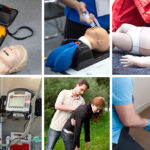When it comes to ensuring the health and safety of your dog, the first thought that probably comes to mind is to rely on your veterinarian. Making sure that your pet receives regular check-ups, and the recommended vaccinations is extremely important to their overall well-being.
However, as we all know, emergencies can happen. Your dog may deal with an emergency situation when your vet isn’t open. In addition, they may deal with a serious event that requires immediate attention, so you may not have time to drive over to your veterinarian before intervention is needed. Animal CPR classes may be a lifesaving factor in an emergency situation.
American CPR Care Association is dedicated to making sure you have the knowledge necessary to save a life in the event of cardiac failure–including your furry friends. While we do not specifically offer classes in CPR for animals, in this blog, we will explore that topic. We will explain how to help your dog if they are suffering from cardiac arrest–an event that causes their heart to stop beating. Continue reading to see how to deal with such an emergency and help to save the life of your companion.
Why Would a Dog Need CPR?
CPR, or cardiopulmonary resuscitation, is the act of manually getting the heart to start beating again when it has stopped doing so. Unfortunately, animals can suffer cardiac failure just like humans, so it’s important to know how to revive them if that has happened. Immediate intervention can be vital in saving the life of your pet if their heart stops beating, so it’s important that you know what to look for in order to identify cardiac arrest and how to perform CPR properly.
CPR is necessary when your dog’s heart is no longer beating, so they may need this form of intervention if you see that they have fallen unconscious and are no longer breathing. Before beginning to perform CPR, ensure that your dog is indeed unconscious and unresponsive by trying to get their attention. If they do not respond at all, then it is time to intervene with CPR procedures.
Performing CPR on Small/Medium Dogs (Under 30 lbs.)
If your dog falls unconscious and is not showing signs of breathing, it’s important to intervene immediately with CPR procedures. In order to perform CPR on your dog, utilizing the following steps:
- First, lay your pet down on their side so that their chest is exposed. Make sure to support their head to avoid any damage if you have to move them.
- Next, place your hands on your dog’s chest. You should have your palms laid out so that you have one palm on either side of their chest and are surrounding their heart.
- Next, you must perform chest compressions. Press your palms firmly into your dog’s chest, trying to go down to a depth of about one-third the diameter of their chest.
- Continue offering chest compressions at a rate of approximately 100-120 bpm, just as you would with a human. Remember that the goal is to manually pump the heart with your chest compressions, so they must be firm and rapid. In this way, you will hopefully be able to pump fresh blood throughout the body via the heart. Offer 30 chest compressions, and then switch over to rescue breaths.
- In order to offer rescue breaths to your dog, cover their muzzle with your hand and breath strongly directly into their nose. You should be able to see their chest rise with each breath, so make sure to watch for that while you offer your breaths. If you do not see their chest rising, then it’s likely that you’re not breathing hard enough, so try again in a more forceful manner. If you still don’t see their chest rising, there could be an obstruction in their throat, so you can take a moment to feel their airway with your finger in order to try to hook any foreign objects which may be lodged in their throat.
- Offer two rescue breaths at a time, and then move back to offering 30 chest compressions. Continue this process until they regain consciousness/begin breathing on their own.
- In addition, it’s important to call your veterinarian as soon as possible while offering these life-saving procedures. If you have a cell phone nearby, call yourself while still administering CPR. However, if there is someone else with you, take advantage of that fact, and have them call your vet while you’re offering CPR.
Performing CPR on Medium/Large Dogs (Over 30 lbs.)
When performing CPR on your medium or large-sized dog, there is really only one significant difference, which involves the positioning of your hands when performing chest compressions.
If your dog is over 30 lbs., instead of placing your hands on either side of the heart, it’s important to actually use both hands at once, directly over the heart.
To perform these chest compressions, place one hand on top of the other in the center of your dog’s chest. Again, press down about one-third the diameter of your pet’s chest, and continue offering 30 chest compressions and 2 rescue breaths until your pet shows signs of being alert or until you can transport them to the nearest medical professional.
Conclusion
When it comes to your furry friends, nothing is more important than their health and wellbeing. Make sure that you start performing CPR procedures immediately when dealing with an event of heart failure in your dog. In addition, make sure that you transport them to the nearest emergency veterinary practice as soon as possible. Ensure you get medical professionals on the phone right away while you’re administering CPR procedures, and they will help to walk you through exactly what to do.
At American CPR Care Association, we are passionate about providing knowledge about lifesaving techniques to everyone. Whether you are concerned about reviving the people in your life and around you, or your pets, CPR Care Association’s best online CPR certification courses can help to prepare you in the event of an emergency. For more information about the courses, we offer or to register for one of our courses, visit our website or reach out to us at 1-888-808-9109 or [email protected] today.







